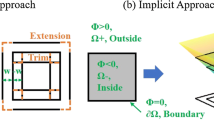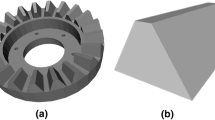Abstract
Additive manufacturing (AM) technology uses the layer-by-layer stacking method to print parts, which simplifies the process of complex parts. The requirements for batch printing in AM are continuously growing now. In order to improve the economic and time efficiency of AM, the printing layout needs to be optimized. However, considering the diversity of part construction directions and accuracy requirements, as well as the limitations of time and materials, the printing layout still lacks comprehensive optimization models and methods, and the existing placement algorithms have not effectively utilized the holes inside parts and gaps between parts. In this paper, a comprehensive weighted general optimization model for 2D nesting is proposed to maximize time and economic benefits in AM. Moreover, a contour similarity matching method based on chain code for part placement is proposed to solve the problems about utilizing holes and gaps for the compact layout, and the approximate optimal solution is obtained by integrating annealing evolution algorithm. Experiments are conducted to verify the effectiveness of the proposed algorithm for regular geometry and real-world part layout.























Similar content being viewed by others
References
Abeysooriya, R. P., Bennell, J. A., & Martinez-Sykora, A. (2017). Efficient local search heuristics for packing irregular shapes in two-dimensional heterogeneous bins. In T. Bektaş, S. Coniglio, A. Martinez-Sykora, S. Voß (Eds.), Computational logistics. ICCL 2017. Lecture Notes in Computer Science (Vol. 10572). Springer. https://doi.org/10.1007/978-3-319-68496-3_37.
Aloui, A., & Hadj-Hamou, K. (2021). A heuristic approach for a scheduling problem in additive manufacturing under technological constraints. Computers & Industrial Engineering, 154, 107115. https://doi.org/10.1016/j.cie.2021.107115
Araújo, L. J. P., Özcan, E., Atkin, J. A. D., & Baumers, M. (2019). Analysis of irregular three-dimensional packing problems in additive manufacturing: A new taxonomy and dataset. International Journal of Production Research, 57(18), 5920–5934. https://doi.org/10.1080/00207543.2018.1534016
Balakrishnan, H. K., Badar, F., Doeven, E. H., Novak, J. I., & Guijt, R. M. (2020). 3D printing: An alternative microfabrication approach with unprecedented opportunities in design. Analytical Chemistry, 93(1), 350–366. https://doi.org/10.1021/acs.analchem.0c04672
Berman, B. (2012). 3-D printing: The new industrial revolution. Business Horizons, 55(2), 155–162. https://doi.org/10.1016/j.bushor.2011.11.003
Bernard, A., & Fischer, A. (2002). New trends in rapid product development. CIRP Annals—Manufacturing Technology, 51(2), 635–652. https://doi.org/10.1016/S0007-8506(07)61704-1
Błażewicz, J., Hawryluk, P., & Walkowiak, R. (1993). Using a tabu search approach for solving the two-dimensional irregular cutting problem. Annals of Operations Research, 41, 313–325. https://doi.org/10.1007/BF02022998
Bouganis, A., & Shanahan, M. (2007). A vision-based intelligent system for packing 2-D irregular shapes. IEEE Transactions on Automation Science and Engineering, 4(3), 382–394. https://doi.org/10.1109/TASE.2006.887158
Canellidis, V., Dedoussis, V., Mantzouratos, N., & Sofianopoulou, S. (2006). Pre-processing methodology for optimizing stereolithography apparatus build performance. Computers in Industry, 57(5), 424–436. https://doi.org/10.1016/j.compind.2006.02.004
Canellidis, V., Giannatsis, J., & Dedoussis, V. (2013). Efficient parts nesting schemes for improving stereolithography utilization. Computer-Aided Design, 45(5), 875–886. https://doi.org/10.1016/j.cad.2012.12.002%20
Dvorak, F., Micali, M., & Mathieug, M. (2018). Planning and scheduling in additive manufacturing. Inteligencia Artificial, 21(62), 40–52. https://doi.org/10.4114/intartif.vol21iss62pp40-52
Evtimov, G., & Fidanova, S. (2018). Heuristic Algorithm for 2D Cutting Stock Problem. In I. Lirkov, & S. Margenov (Eds.), Large-scale scientific computing. LSSC 2017. Lecture Notes in Computer Science (Vol. 10665). Springer. https://doi.org/10.1007/978-3-319-73441-5_37.
Fang, J., Rao, Y., Liu, P., & Zhao, X. (2021). Sequence transfer-based particle swarm optimization algorithm for irregular packing problems. IEEE Access, 9, 131223–131235. https://doi.org/10.1109/ACCESS.2021.3114331
Gao, W., Zhang, Y., Ramanujan, D., Ramani, K., Chen, Y., Williams, C. B., Wang, C. C. L., Shin, Y. C., Zhang, S., & Zavattieri, P. D. (2015). The status, challenges, and future of additive manufacturing in engineering. Computer-Aided Design, 69, 65–89. https://doi.org/10.1016/j.cad.2015.04.001
Gardan, J. (2015). Additive manufacturing technologies: State of the art and trends. International Journal of Production Research, 54(10), 3118–3132. https://doi.org/10.1080/00207543.2015.1115909
Gardan, J. (2018). Smart materials in additive manufacturing: State of the art and trends. Virtual and Physical Prototyping, 14(1), 1–18. https://doi.org/10.1080/17452759.2018.1518016
Gebler, M., Uiterkamp, A., & Visser, C. (2014). A global sustainability perspective on 3D printing technologies. Energy Policy, 74, 158–167. https://doi.org/10.1016/j.enpol.2014.08.033
Gogate, A. S., & Pande, S. S. (2008). Intelligent layout planning for rapid prototyping. International Journal of Production Research, 46(20), 5607–5631. https://doi.org/10.1080/00207540701277002
Guo, B., Ji, Y., Hu, J., Wu, F., & Peng, Q. (2019). Efficient free-form contour packing based on code matching strategy. IEEE Access, 7, 57917–57926. https://doi.org/10.1109/ACCESS.2019.2914248
Guo, B., Hu, J., Wu, F., & Peng, Q. (2020). Automatic layout of 2D free-form shapes based on geometric similarity feature searching and fuzzy matching. Journal of Manufacturing Systems, 56, 37–49. https://doi.org/10.1016/j.jmsy.2020.04.019
Guo, N., & Leu, M. C. (2013). Additive manufacturing: Technology, applications and research needs. Frontiers of Mechanical Engineering, 8(3), 215–243. https://doi.org/10.1007/s11465-013-0248-8
Jakobs, S. (1996). On genetic algorithms for the packing of polygons. European Journal of Operational Research, 88(1), 165–181. https://doi.org/10.1016/0377-2217(94)00166-9
Jones, D. R. (2014). A fully general, exact algorithm for nesting irregular shapes. Journal of Global Optimization., 59, 367–404. https://doi.org/10.1007/s10898-013-0129-z
Kucukkoc, I., Li, Q., & Zhang, D. Z. (2016). Increasing the utilisation of additive manufacturing and 3D printing machines considering order delivery times. In 19th International Working Seminar on Production Economics, Innsbruck, Austria, February 22–26, 195–201. Retrieved from https://www.researchgate.net/publication/318373931_Increasing_the_utilisation_of_additive_manufacturing_and_3D_printing_machines_considering_order_delivery_times
Lee, W. C., Ma, H., & Cheng, B. W. (2008). A heuristic for nesting problems of irregular shape. Computer-Aided Design, 40(5), 625–633. https://doi.org/10.1016/j.cad.2008.02.008
Martins, T. C., & Tsuzuki, M. S. G. (2010). Simulated annealing applied to the irregular rotational placement of shapes over containers with fixed dimensions. Expert Systems with Applications, 37(3), 1955–1972. https://doi.org/10.1016/j.eswa.2009.06.081
Nixon, M. S., & Aguado, A. S. (2012). Chapter 7—Object description. In M. S. Nixon & A. S. Aguado (Eds.), Feature extraction & image processing for computer vision (3rd ed., pp. 343–397). Academic Press. https://doi.org/10.1016/B978-0-12-396549-3.00007-0
Oliveira, J. F. C., & Ferreira, J. A. S. (1993). Algorithms for nesting problems. In R. V. V. Vidal (Ed.), Applied simulated annealing. Lecture Notes in Economics and Mathematical Systems (Vol. 396). Springer. https://doi.org/10.1007/978-3-642-46787-5_13.
Oliveira, J. F., Gomes, A. M., & Ferreira, J. S. (2000). TOPOS—A new constructive algorithm for nesting problems. Or Spektrum, 22, 263–284. https://doi.org/10.1007/s002910050105
Rocha, A. M. A. C., Pereira, A. I., & Vaz, A. I. F. (2018) Build Orientation Optimization Problem in Additive Manufacturing. In O. Gervasi et al. (Eds.), Computational science and its applications. ICCSA 2018: Lecture Notes in Computer Science (pp. 669–682). Springer. https://doi.org/10.1007/978-3-319-95165-2_47.
Sato, A. K., Martins, T. D. C., & Tsuzuki, M. D. S. G. (2016). A pairwise exact placement algorithm for the irregular nesting problem. International Journal of Computer Integrated Manufacturing, 29(11), 1177–1189. https://doi.org/10.1080/0951192X.2015.1033018
Stampfl J., & Hatzenbichler M. (2014). Additive manufacturing technologies. In L. Laperrière, & G. Reinhart (Eds.), The international academy for production engineering. CIRP Encyclopedia of Production Engineering. Springer. https://doi.org/10.1007/978-3-642-20617-7_6492
Terashima-Marín, H., Ross, P., Farías-Zárate, C. J., López-Camacho, E., & Valenzuela-Rendón, M. (2010). Generalized hyper-heuristics for solving 2D regular and irregular packing problems. Annals of Operations Research, 179, 369–392. https://doi.org/10.1007/s10479-008-0475-2
Veeman, D., Sai, M. S., Sureshkumar, P., Jagadeesha, T., & Mammo, W. D. (2021). Additive manufacturing of biopolymers for tissue engineering and regenerative medicine: An overview, potential applications, advancements, and trends. International Journal of Polymer Science, 2021, 1–20. https://doi.org/10.1155/2021/4907027
Yau, H. T., & Hsu, C. W. (2022). Nesting of 3D irregular shaped objects applied to powder-based additive manufacturing. The International Journal of Advanced Manufacturing Technology, 118, 1843–1858. https://doi.org/10.1007/s00170-021-07954-y
Zhang, Y., Bernard, A., Harik, R., & Fadel, G. (2018). A new method for single-layer-part nesting in additive manufacturing. Rapid Prototyping Journal, 24(5), 840–854. https://doi.org/10.1108/RPJ-01-2017-0008
Zhang, Y., Gupta, R. K., & Bernard, A. (2016). Two-dimensional placement optimization for multi-parts production in additive manufacturing. Robotics and Computer Integrated Manufacturing, 38, 102–117. https://doi.org/10.1016/j.rcim.2015.11.003
Zhang, J., Yao, X., & Li, Y. (2020). Improved evolutionary algorithm for parallel batch processing machine scheduling in additive manufacturing. International Journal of Production Research, 58(8), 2263–2282. https://doi.org/10.1080/00207543.2019.1617447
Zhao, J. (2005). Determination of optimal build orientation based on satisfactory degree theory for RPT. In Ninth international conference on computer aided design and computer graphics (CAD-CG'05) (pp. 225–230). https://doi.org/10.1109/CAD-CG.2005.32.
Funding
This research did not receive any specific grant from funding agencies in the public, commercial, or not-for-profit sectors.
Author information
Authors and Affiliations
Corresponding author
Additional information
Publisher's Note
Springer Nature remains neutral with regard to jurisdictional claims in published maps and institutional affiliations.
Rights and permissions
About this article
Cite this article
Yang, Y., Liu, B., Li, H. et al. A nesting optimization method based on digital contour similarity matching for additive manufacturing. J Intell Manuf 34, 2825–2847 (2023). https://doi.org/10.1007/s10845-022-01967-4
Received:
Accepted:
Published:
Issue Date:
DOI: https://doi.org/10.1007/s10845-022-01967-4




